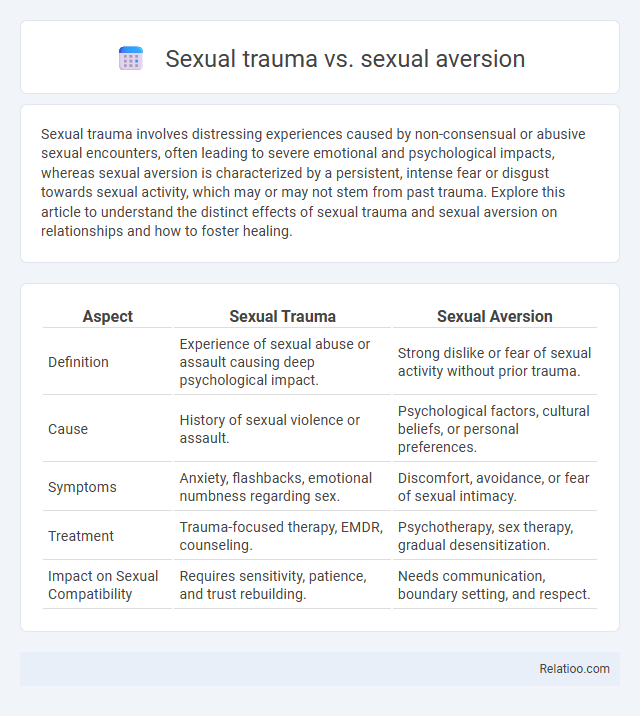Sexual trauma involves distressing experiences caused by non-consensual or abusive sexual encounters, often leading to severe emotional and psychological impacts, whereas sexual aversion is characterized by a persistent, intense fear or disgust towards sexual activity, which may or may not stem from past trauma. Explore this article to understand the distinct effects of sexual trauma and sexual aversion on relationships and how to foster healing.
Table of Comparison
| Aspect | Sexual Trauma | Sexual Aversion |
|---|---|---|
| Definition | Experience of sexual abuse or assault causing deep psychological impact. | Strong dislike or fear of sexual activity without prior trauma. |
| Cause | History of sexual violence or assault. | Psychological factors, cultural beliefs, or personal preferences. |
| Symptoms | Anxiety, flashbacks, emotional numbness regarding sex. | Discomfort, avoidance, or fear of sexual intimacy. |
| Treatment | Trauma-focused therapy, EMDR, counseling. | Psychotherapy, sex therapy, gradual desensitization. |
| Impact on Sexual Compatibility | Requires sensitivity, patience, and trust rebuilding. | Needs communication, boundary setting, and respect. |
Defining Sexual Trauma: Key Concepts
Sexual trauma involves experiences of sexual abuse, assault, or exploitation that cause significant psychological and emotional harm. Sexual aversion refers to an individual's strong, persistent dislike or avoidance of sexual activity, often stemming from past negative experiences, including sexual trauma. Understanding sexual trauma requires recognizing its impact on mental health, consent boundaries, trust issues, and its potential to trigger sexual aversion as a protective response.
Understanding Sexual Aversion: An Overview
Sexual aversion is a condition marked by a persistent or recurrent extreme dislike or fear of sexual contact, often rooted in underlying sexual trauma or negative experiences. Unlike general sexual trauma, which refers to the event or series of events causing psychological harm, sexual aversion specifically describes the emotional and behavioral response that can develop afterward. Understanding your sexual aversion involves recognizing how past trauma influences current feelings toward intimacy, guiding effective therapeutic approaches and healing strategies.
Causes of Sexual Trauma: Common Triggers
Sexual trauma often results from experiences such as sexual assault, abuse, or coercion, which can deeply impact an individual's psychological well-being. Triggers frequently include reminders like certain smells, sounds, or situations that resemble the original traumatic event, causing flashbacks or intense emotional reactions. Sexual aversion, while sometimes linked to sexual trauma, specifically refers to an avoidance or fear of sexual activity rather than the trauma itself.
Origins of Sexual Aversion: Psychological and Biological Factors
Sexual aversion often originates from a combination of psychological and biological factors, including past sexual trauma, anxiety disorders, and hormonal imbalances. Early adverse experiences or abuse can imprint persistent fear and avoidance behaviors toward sexual activity, while neurochemical disruptions may reduce sexual desire or increase discomfort. Understanding these intertwined origins is critical for tailored therapeutic approaches addressing both mental health and physiological components.
Symptoms: Sexual Trauma vs Sexual Aversion
Sexual trauma symptoms often include flashbacks, nightmares, and intense emotional distress related to past abuse, while sexual aversion typically manifests as persistent fear, anxiety, or disgust toward sexual activity. Your emotional response to sexual encounters may be marked by avoidance and physical reactions such as nausea or panic in cases of aversion. Understanding these distinct symptoms helps in identifying whether healing or therapeutic intervention is necessary for recovery.
Impact on Relationships and Intimacy
Sexual trauma often leads to deep emotional scars that significantly impair trust and emotional closeness, making intimacy challenging and strain relationships. Sexual aversion, characterized by an intense dislike or fear of sexual activity, can stem from trauma but also from other psychological or physiological factors, resulting in decreased sexual desire and avoidance that impact partner connection and communication. Both conditions require sensitive therapeutic approaches to rebuild trust, promote healing, and foster healthy intimacy, ultimately improving relationship satisfaction and emotional bonding.
Diagnosis and Assessment: Differentiating the Two
Sexual trauma and sexual aversion require distinct diagnostic approaches due to their differing underlying causes and symptom presentations. Sexual trauma diagnosis focuses on identifying symptoms of post-traumatic stress disorder (PTSD), such as flashbacks, anxiety, and hypervigilance, often utilizing trauma history and clinical interviews. In contrast, sexual aversion assessment emphasizes understanding discomfort or fear related to sexual activity without trauma history, often involving psychosexual evaluations and questionnaires to differentiate from trauma-related responses.
Treatment Approaches: Trauma and Aversion
Treatment approaches for sexual trauma often involve trauma-focused therapies such as EMDR and cognitive-behavioral therapy to address deeply rooted emotional wounds and PTSD symptoms. In contrast, sexual aversion is commonly treated with behavioral therapy methods, including systematic desensitization and exposure techniques, aimed at reducing fear and anxiety related to sexual activities. Your healing journey may require personalized interventions that combine these approaches to effectively address both trauma and aversion symptoms.
Healing and Recovery: Support Strategies
Healing from sexual trauma involves trauma-informed therapy approaches such as EMDR and cognitive-behavioral therapy, which target PTSD and emotional regulation. Sexual aversion disorder often requires a combination of sex therapy and counseling to address negative associations and fears around intimacy. Support strategies include building safe environments, peer support groups, and personalized treatment plans to foster trust and gradual recovery consistent with individual needs.
Breaking the Stigma: Promoting Sexual Wellbeing
Sexual trauma, sexual aversion, and their impacts require open dialogue to break the stigma and promote holistic sexual wellbeing. Understanding the differences--sexual trauma involving abusive experiences while sexual aversion reflects avoidance or fear of sexual contact--enables targeted therapeutic approaches. Prioritizing education, supportive counseling, and trauma-informed care fosters healing and empowers survivors toward positive sexual health.

Infographic: Sexual trauma vs sexual aversion
 relatioo.com
relatioo.com